America’s 82 top nonprofit hospital groups have experienced massive growth in annual revenues and asset value even as health care costs for most families and individuals are zooming upward, according to a report by government watchdog Open The Books.
The release of the report compiled by the Chicago-based transparency advocacy group came one day after President Donald Trump signed on June 24 an executive order mandating public disclosure by hospitals of the actual costs of their services.





